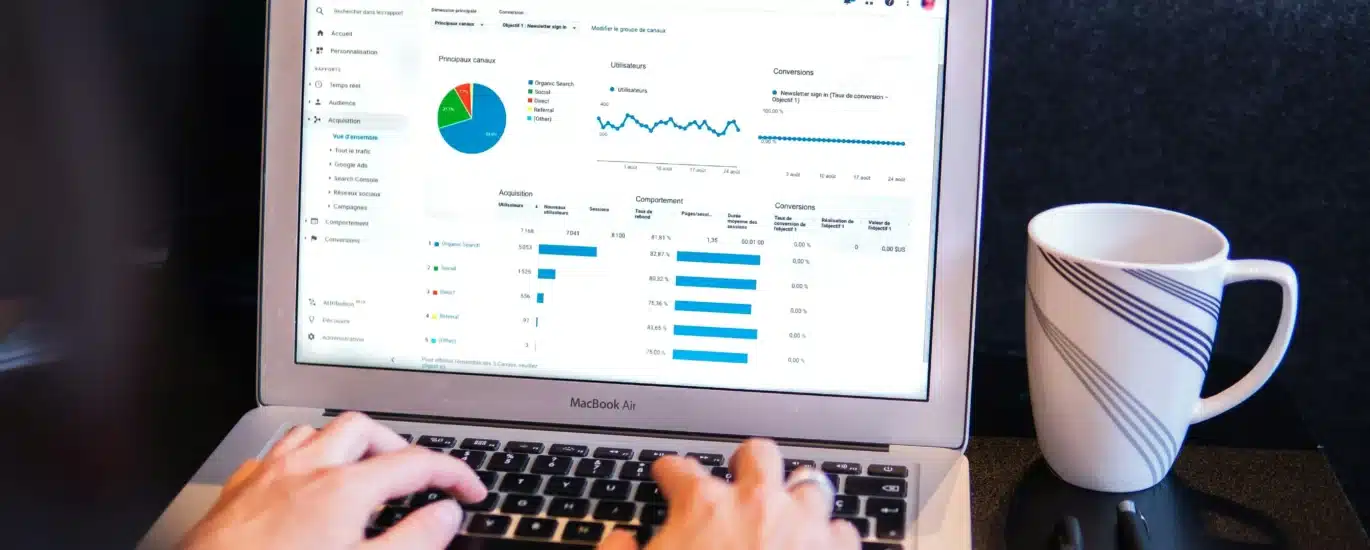Unlocking the Power of Google Analytics: A Guide for 2025
In today’s data-driven world, understanding your audience is the key to success in digital marketing. That’s where Google Analytics comes in—a powerful tool that gives you deep insights into your website performance, user behavior, and marketing effectiveness.
Whether you’re a business owner, marketer, or analyst, mastering Google Analytics can help you make informed decisions and achieve your goals. In this blog post, we’ll explore what Google Analytics offers in 2025 and how to use it effectively.
What Is Google Analytics?
Google Analytics is a free web analytics tool that helps you track and report website traffic and user behavior. The platform collects data about your website visitors—where they come from, how they interact with your site, and whether they take desired actions (like making a purchase or filling out a form).
With the introduction of Google Analytics 4 (GA4), the tool has evolved into a more comprehensive platform, focusing on event-based tracking and cross-platform analysis.
Key Features of Google Analytics 4 (GA4)
-
Event-Based Tracking
GA4 tracks user interactions as events (e.g., clicks, page views, video plays), offering more granular insights. -
Cross-Platform Tracking
GA4 allows you to track user activity across websites, apps, and devices, giving a holistic view of customer journeys. -
AI-Powered Insights
Built-in machine learning tools provide predictive analytics, helping you forecast user behavior and trends. -
Privacy-First Approach
GA4 is designed to comply with privacy regulations like GDPR and CCPA, using cookieless tracking methods. -
Customizable Reports
Tailor reports to focus on metrics that matter most to your business.
Why Use Google Analytics?
-
Understand Your Audience:
Learn who your visitors are—demographics, interests, and geographic locations. -
Track Performance:
Monitor traffic sources, bounce rates, and conversion rates to assess your website’s effectiveness. -
Optimize Marketing Campaigns:
Measure the ROI of your marketing efforts, from social media ads to email campaigns. -
Improve User Experience:
Identify bottlenecks in your website navigation and fix issues to boost engagement. -
Set and Measure Goals:
Track specific objectives, like newsletter sign-ups or product purchases, to see how well your website supports your business goals.
Getting Started with Google Analytics
-
Set Up Your Account
- Sign in to Google Analytics with your Google account.
- Create a property (website or app) and set up a data stream.
-
Install Tracking Code
- Add the provided tracking code to your website’s header to start collecting data.
-
Define Goals
- Use the “Conversions” feature to set goals, such as completing a purchase or filling out a form.
-
Link Google Tools
- Integrate with Google Ads, Search Console, and other tools to get a complete picture of your online performance.
Top Metrics to Track in Google Analytics
-
Users and Sessions
- Understand how many people visit your site and how often they return.
-
Bounce Rate
- Track the percentage of visitors who leave without interacting further.
-
Traffic Sources
- Know where your visitors are coming from (e.g., organic search, paid ads, social media).
-
Conversion Rate
- Measure how many users complete a desired action, like making a purchase.
-
Average Session Duration
- See how long visitors stay on your site.
Advanced Tips for Using Google Analytics
-
Use UTM Parameters:
Track specific campaigns by adding UTM codes to your URLs. -
Leverage Custom Dashboards:
Create tailored dashboards to see key metrics at a glance. -
Enable Enhanced E-Commerce:
For online stores, track product impressions, clicks, and purchases in detail. -
Analyze Audience Segments:
Break down your audience into segments based on behavior, demographics, or geography. -
Set Up Event Tracking:
Track specific actions like video plays, file downloads, or button clicks.
Google Analytics Best Practices
-
Check Reports Regularly:
Consistently monitor data to stay updated on trends and performance. -
Align Analytics with Business Goals:
Focus on metrics that directly impact your objectives, like lead generation or sales. -
Combine with Other Tools:
Integrate Google Analytics with tools like Google Ads and CRM platforms for deeper insights. -
Stay Updated on Features:
GA4 is continually evolving, so keep an eye on new capabilities and updates.
Google Analytics Trends in 2025
Google Analytics (GA) continues to be a cornerstone for businesses aiming to understand their audience and optimize their online presence. As we step into 2025, several emerging trends are shaping the way businesses interact with Google Analytics, driven by advancements in technology, evolving consumer behavior, and the growing importance of privacy regulations. In this article, we’ll explore the major trends in Google Analytics and how they are redefining the digital analytics landscape.
1. Google Analytics – Privacy-First Analytics: Adapting to Evolving Regulations
The Privacy Landscape
With increasing global emphasis on data privacy, frameworks like GDPR (General Data Protection Regulation), CCPA (California Consumer Privacy Act), and the upcoming ePrivacy Regulation are making compliance non-negotiable for businesses. By 2025, these regulations have tightened further, compelling organizations to rethink how they collect, store, and process user data.
GA4’s Privacy-Centric Approach
Google Analytics 4 (GA4) is designed to thrive in this privacy-first world. Unlike its predecessor, Universal Analytics, GA4 prioritizes anonymized data collection, user consent, and cookieless tracking. Key features include:
- Event-Based Data Model: GA4’s event-based architecture enables more granular tracking without relying on cookies.
- Enhanced Consent Modes: Businesses can now tailor analytics configurations based on user consent preferences, ensuring compliance without sacrificing valuable insights.
Action Steps for Businesses
- Audit Your Analytics Setup: Ensure your data collection aligns with the latest regulations.
- Educate Stakeholders: Train teams on how GA4 integrates privacy compliance with data-driven decision-making.
- Leverage AI for Data Gaps: Use machine learning models in GA4 to fill data gaps caused by users opting out of tracking.
2.Google Analytics – The Rise of AI and Machine Learning in Analytics
AI-Driven Insights
In 2025, artificial intelligence (AI) and machine learning (ML) are no longer optional tools but integral components of Google Analytics. These technologies empower businesses to:
- Predict user behavior.
- Automate complex data analysis.
- Identify trends and anomalies in real-time.
Predictive Metrics in GA4
GA4 leverages predictive metrics such as purchase probability, churn probability, and revenue prediction. These insights enable businesses to proactively target high-value users and improve customer retention.
AI-Powered Automation
- Anomaly Detection: Automated alerts flag unusual spikes or drops in traffic, helping teams act swiftly.
- Smart Segmentation: Machine learning identifies audience segments likely to convert, enabling more precise targeting.
Action Steps for Businesses
- Invest in AI Training: Ensure your analytics team understands how to interpret and act on AI-driven insights.
- Adopt Predictive Models: Use GA4’s predictive metrics to refine marketing strategies and allocate budgets effectively.
- Integrate Automation Tools: Pair GA4 with automation platforms for seamless execution of data-driven campaigns.
3.Google Analytics – Cookieless Tracking and First-Party Data Strategies
The End of Third-Party Cookies
As browsers like Chrome phase out third-party cookies by 2025, marketers must rely on alternative data sources. GA4’s cookieless tracking capabilities are a game-changer in this environment.
Focus on First-Party Data
First-party data—information collected directly from your audience—has become the cornerstone of effective analytics. GA4’s integration with Google’s broader ecosystem (e.g., Google Ads, Search Console) ensures seamless utilization of first-party data.
Server-Side Tagging
To address cookie limitations, businesses are increasingly adopting server-side tagging. This method enhances data accuracy and privacy by processing analytics requests on your server instead of users’ browsers.
Action Steps for Businesses
- Develop a Data Collection Plan: Focus on capturing meaningful first-party data through user interactions.
- Implement Server-Side Tagging: Improve tracking reliability and mitigate data loss.
- Educate Users: Clearly communicate data collection policies to build trust and encourage consent.
4.Google Analytics – Enhanced Integration with Google Ecosystem
Seamless Connectivity
By 2025, Google Analytics serves as the central hub for Google’s ecosystem, integrating seamlessly with platforms like Google Ads, BigQuery, and Firebase. These integrations allow businesses to:
- Unify data across channels.
- Create end-to-end customer journey maps.
- Optimize campaigns with cross-platform insights.
BigQuery for Advanced Analytics
BigQuery, Google’s cloud-based data warehouse, is a vital tool for businesses handling large datasets. GA4’s native integration with BigQuery enables advanced analysis, such as:
- SQL-based custom queries.
- Data enrichment using external sources.
- Real-time dashboarding for actionable insights.
Action Steps for Businesses
- Leverage Cross-Platform Insights: Use GA4 to consolidate data from Google Ads, YouTube, and other platforms.
- Adopt BigQuery: Invest in BigQuery to perform deeper analysis and gain a competitive edge.
- Streamline Data Workflows: Ensure your analytics stack is fully integrated to eliminate silos.
5.Google Analytics – Increased Focus on Attribution Modeling
Multi-Touch Attribution
Traditional last-click attribution models are insufficient for understanding complex user journeys in 2025. GA4 introduces robust attribution modeling capabilities, including:
- Data-Driven Attribution (DDA): Machine learning assigns credit to each touchpoint based on its impact.
- Cross-Channel Insights: Understand how various channels work together to drive conversions.
Shift to Real-Time Attribution
Real-time data processing in GA4 allows marketers to evaluate the effectiveness of campaigns instantly. This agility is crucial for optimizing live campaigns and maximizing ROI.
Action Steps for Businesses
- Adopt Data-Driven Attribution: Transition from outdated models to GA4’s DDA for more accurate insights.
- Analyze Cross-Channel Impact: Use attribution reports to identify high-performing channels and allocate budgets effectively.
- Optimize in Real-Time: Continuously monitor attribution data to adjust campaigns dynamically.
6. Google Analytics – Advanced Customization with APIs and Third-Party Tools
Custom Analytics Solutions
By 2025, businesses demand highly tailored analytics solutions. GA4’s robust API capabilities allow for:
- Integration with third-party tools like CRM systems.
- Custom event tracking based on unique business requirements.
- Automated data pipelines for real-time reporting.
Third-Party Enhancements
Many organizations use analytics platforms like Tableau, Power BI, or Looker to enhance GA4’s visualization capabilities. This combination creates a comprehensive analytics ecosystem.
Action Steps for Businesses
- Explore API Capabilities: Develop custom analytics solutions to meet specific business needs.
- Integrate Third-Party Tools: Combine GA4 with visualization and reporting tools for advanced insights.
- Automate Reporting: Use APIs to create automated dashboards and streamline decision-making.
7.Google Analytics – Voice and Visual Search Analytics
Emerging Search Trends
Voice and visual search are transforming the way users find information. By 2025, these technologies are integral to search engine interactions, and GA4 adapts by offering:
- Voice Search Reporting: Insights into how users interact with voice-enabled devices.
- Visual Search Analytics: Metrics on image-based search behavior.
Optimizing for Search Innovations
Businesses must optimize their content for voice and visual search to remain competitive. GA4 provides actionable insights to enhance visibility and engagement.
Action Steps for Businesses
- Analyze Search Trends: Use GA4’s reports to understand how voice and visual search impact your traffic.
- Optimize Content: Tailor content to meet the demands of voice and visual search users.
- Track Search Performance: Continuously monitor metrics to refine your strategy.
8.Google Analytics – Real-Time Analytics for Immediate Action
The Need for Speed
In 2025, businesses rely heavily on real-time analytics to make swift, data-driven decisions. GA4’s real-time reporting capabilities allow organizations to:
- Monitor live user behavior.
- Identify and act on traffic spikes or dips.
- Optimize campaigns instantly.
Use Cases for Real-Time Analytics
- Event Monitoring: Track the performance of live events or promotions.
- Crisis Management: Respond to technical issues or PR crises promptly.
- Customer Support: Analyze real-time data to enhance user experiences.
Action Steps for Businesses
- Set Up Real-Time Dashboards: Ensure stakeholders have access to up-to-date metrics.
- Use Alerts Effectively: Configure alerts for key performance indicators (KPIs) to stay informed.
- Act Proactively: Leverage real-time insights to address issues before they escalate.
9. Google Analytics – User-Centric Metrics: Engagement Over Pageviews
New Metrics in GA4
GA4 introduces a shift from traditional metrics like pageviews to user-centric measurements. Key metrics include:
- Engaged Sessions: Sessions lasting longer than 10 seconds, with multiple interactions.
- Engagement Rate: A more meaningful alternative to bounce rate.
- Lifetime Value (LTV): Insights into long-term user value.
Focusing on Quality
These metrics emphasize user quality over quantity, enabling businesses to understand true engagement and optimize accordingly.
Action Steps for Businesses
- Prioritize Engagement Metrics: Monitor engaged sessions and engagement rate for a clearer picture of user behavior.
- Track Lifetime Value: Use LTV metrics to focus on high-value users.
- Refine Content Strategy: Tailor content to drive meaningful interactions.
10. Google Analytics – The Role of Sustainability in Analytics
Sustainability Metrics
By 2025, sustainability is a key concern for businesses and consumers alike. GA4 supports this trend by offering tools to measure the environmental impact of digital operations, such as:
- Carbon emissions from digital advertising.
- Energy usage of website servers.
Green Analytics Practices
Businesses are adopting green analytics practices, such as optimizing websites for energy efficiency and minimizing unnecessary data storage.
Action Steps for Businesses
- Measure Digital Footprint: Use GA4 to track and report sustainability metrics.
- Optimize for Efficiency: Reduce resource-heavy processes and improve website performance.
- Communicate Sustainability Efforts: Highlight green initiatives to attract eco-conscious audiences.
Conclusion
Google Analytics in 2025 is more dynamic, user-centric, and privacy-focused than ever before. From leveraging AI for predictive insights to navigating a cookieless future with first-party data strategies, businesses must stay ahead of these trends to remain competitive. By embracing GA4’s innovative features and aligning with emerging practices, organizations can unlock the full potential of their analytics efforts and drive meaningful growth.
Whether you’re a small business owner or a global enterprise, the time to adapt is now. Stay informed, invest in the right tools, and prioritize data-driven decision-making to thrive in this ever-evolving digital landscape.
Ready to make the most of your data? Start exploring Google Analytics today and unlock its full potential!
Here are some links about Google Analytics
https://trends.google.com/trends/
https://hyperight.com/top-5-data-and-analytics-trends-to-watch-in-2025/

SEO Trends in 2025: Staying Ahead of the Curve
SEO Trents in 2025 -Search Engine Optimization (SEO) is ever-changing, driven by advancements in technology, user behavior, and search engine algorithms. As we step into 2025, businesses need to stay updated on the latest trends to maintain visibility and competitiveness online. Here’s what you need to know about the SEO landscape this year...

10 Best Email Marketing Tips & Tricks
In a world dominated by social media and instant messaging, one might wonder if email marketing is still relevant. The truth? Email marketing remains one of the most effective and reliable digital marketing tools available. With an average return on investment (ROI) of $36 for every $1 spent, it’s clear that email marketing isn’t just surviving—it’s thriving...

Marketing Trends in 2025
As we move further into the digital age, 2025 brings with it a dynamic landscape of marketing trends. Businesses need to stay ahead of these shifts to maintain relevance and connect with their audiences effectively. Here are the top marketing trends poised to dominate 2025, offering insights into how companies can innovate and thrive.
